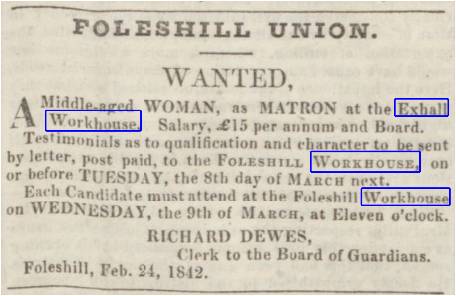3 of 136 26th Oct 2025 7:23pm
Coventry Union workhouse (Click to see this topic in full)From the early 19th century there were two
workhouses covering what is now Coventry: Coventry
workhouse itself and Foleshill
workhouse. Coventry
workhouse was housed in the old Whitefriars Monastery. This still survives, next to Coventry University carpark, although parts of the
workhouse (such as what became the Gulson Hospital) were demolished fairly recently. Nothing remains of Foleshill
workhouse; it was demolished and an industrial estate built on the site.
https://www.
workhouses.org.uk/ is a brilliant website which provides a mass of detail on specific
workhouses - simply type in the name of the place you are interested in to the search box. It contains a lot of pictures of Coventry
workhouse. It also lists (something which is very useful) the ca.1812
workhouse are a rich source of information; I know, because I spent a lot of time carrying out research on the admission and discharge registers for the 19th century. I have not used the 20th century admission and discharge registers, and there are some gaps in the holdings for the 19th century registers. It is best to check on the
workhouses website listed above.
If you are interested in a particular person who was an inmate at the
workhouse in Coventry, I suggest that you contact Coventry Archives, or Coventry Family History Centre, or a private genealogist who works in the Coventry area. I am not sure whether Coventry (or Foleshill) had a chapel; they probably did.
I hope this is of help.
Rosemary Hall (If I can be of more help do not hesitate to get in touch.)
P S Before individual parishes like Exhall had their own
workhouses; by the 19th century Exhall would have come under Foleswhill - for more detail, see the
workhouses website.





![Next page [or press the "Right arrow" key] Next page](../resource/colour_tint_inc.php?img_file=right-arrow.png&clr=AA5511)
![Last page [or press the "L" key] Last page](../resource/colour_tint_inc.php?img_file=right-arrow-end.png&clr=AA5511)
 By 1849 the salary had gone up to £20.
Hopefully someone else can be more helpful.
By 1849 the salary had gone up to £20.
Hopefully someone else can be more helpful.

 The clippings state:
Brigadier Thomas Hutchison was in charge of the crumbling, old Salvation Army Hostel from May 1965 to February 1968. The crumbling former
The clippings state:
Brigadier Thomas Hutchison was in charge of the crumbling, old Salvation Army Hostel from May 1965 to February 1968. The crumbling former  All this was despite a 're-opening' in 1956 - which indicates to me the poor condition the buildings were in to decline again within 10-or so years -
All this was despite a 're-opening' in 1956 - which indicates to me the poor condition the buildings were in to decline again within 10-or so years -

